If you want to know about the Egyptian architecture or Indus valley civilization or evolution of Hindu temple architecture, please click the link.
Greek architecture is a style of architecture that originated in ancient Greece and lasted from the 5th century BCE to the end of the Hellenistic period in the 1st century BCE. It is known for its harmony of form, proportion, and the use of columns, pediments, and friezes.
Our word “architecture” comes from the Greek architecton, which means “master carpenter.” Early Greek architecture therefore employed wood, not stone. These early structures, as well as those of mudbrick, have not survived. The Ancient Greeks had a unique style of architecture that is still copied today in government buildings and major monuments throughout the world.
Greek architecture is known for tall columns, intricate detail, symmetry, harmony, and balance. The Greeks built all sorts of buildings. The main examples of Greek architecture that survive today are the large temples that they built to their gods. The most famous temple of Ancient Greece is the Parthenon located on the Acropolis in the city of Athens.
1) Introduction
- Ancient Greece was used to describe the Greek-speaking world in ancient times.
- It refers not only to the geographical peninsula of modern Greece but comprises of Hellenic culture that were settled in ancient times by Greeks: Cyprus, the Aegean coast of Turkey (then known as Ionia), Sicily and southern Italy (known as Magna Graecia), and the scattered Greek settlements on the coasts of what is now Albania, Bulgaria, Egypt, southern France, Libya, Romania, Catalonia, and Ukraine.
- Involves paintings, sculpture, buildings and decorative arts produced from about 3000-30BC.
- Importance of Greek architecture to history of western civilization can hardly be overstated.
- Greek artists were the first to establish mimesis (imitation of nature) as a guiding principle for art.
- The description of the nude human figure in Greek art reflects Greek humanism – a believe that ‘Man is the measure of all things’.
- Its primary subject matter of the art is the human figure, which may represent gods or mortals, monsters, animals and plants.
- Greek architecture is a legacy that the west has inherited, as they established many of the most enduring themes, attitudes and forms of western culture (e.g. structural elements, decorative motifs and building types still used in architecture today).
2) Architectural influences
i) Geographical

- A thousand years before Greek civilization reached its peak, flourished the Aegean culture of the people of the Island of Crete (Cretans are also known as Minoans) who were the first great sea-power of the Mediterranean.
- The civilization grew and expanded, developing a commercial empire protected by naval power.
- Crafts, pottery, communications and trade through coastal towns produced a unity of culture and economic stability.
- Their trade route extended to Greece and her islands and along the whole eastern Mediterranean seaports, which include Asia Minor, Cyprus, Syria, Palestine, Egypt and Libya extending to south Italy and Sicily.
- After the collapse of the Aegean culture, the Greek colonist took over their trade routes, thus establishing their domain not only in the Greece motherland.
- The rugged nature of Greece and its islands, with mountainous hinterlands rendered internal communication difficult and made the sea the inevitable means of interrelationship.
- The mountains of inland Greece separated the inhabitants into groups or clans (city-states), leading to the rivalry which characterized the Greek states, whether in peace or war.
ii) Geological
- Little supply of building stone, but abundant supply of marble.
- The marble – the most beautiful and monumental building material – gave a great credence and characteristics to Greek architecture because it facilitates exactness of outlines and refinement of details.
- Even where coarse-grained limestones were used, they often coat the surface with a layer of marble “stucco” in order to achieve this effect.
iii) Climatic
- The climate of Greece is maritime, with both the coldness of winter and the heat of summer tempered by sea breezes.
- This led to a lifestyle where many activities took place outdoors.
- Hence temples were placed on hilltops, their exteriors designed as a visual focus of gatherings and processions, while theatres were often an enhancement of a naturally occurring sloping site where people could sit, rather than a containing structure. Colonnades encircling buildings, or surrounding courtyards provided shelter from the sun and from sudden winter storms.
- The light of Greece may be another important factor in the development of the particular character of Ancient Greek architecture.
- The light is often extremely bright, with both the sky and the sea vividly blue. The clear light and sharp shadows give a precision to the details of landscape, pale rocky outcrops and seashore. This clarity is alternated with periods of haze that varies in colour to the light on it. In this characteristic environment, the Ancient Greek architects constructed buildings that were marked by precision of detail.
- The gleaming marble surfaces were smooth, curved, fluted, or sculpted to reflect the sun, cast graded shadows and change in colour with the ever-changing light of day.
- The climate is between rigorous cold and relaxing heat.
- The clear atmosphere and intensity of light was conducive for the development of precise, Greek characteristic exact forms.
- The Greeks have a love for conversation; hence they built porticoes and colonnades to shelter them from the hot sun and sudden showers.
iv) Religious
- The religion of “Aegean” was based on nature worship and had many divinities in the form of human, sacred bulls but “Rhea” the goddess of fertility or mother was supreme.
- The worship was carried out in the open air courtyard or small shrines, hence, no temples were built.
- But after the fall of “Aegean”, the Greek began to worship their deities in temples.
- Their religion was based on worship of nature.
- Divinities were conceived in human form, and represented by small idols, rocks and stone pillars; and all sorts of trees and animals were venerated.
- Mysteries of masculine force were represented by the sacred bull, symbolized by the “horns of consecration”.
- The supreme deity was the fertility – or mother-goddess (Hera).
- Priestesses rather than priests conducted the religious rites since their purity can be confirmed.
- Worship centered on sacrificial altars in open-air enclosures, caves, small chapels or household shrines.
- When temple architecture began, the Greeks began to represent their deities by large statues.
- The religious ceremonies of classical Greek included sacred games, ritual dances, athletic contests and arts.
- The Greek gods were personifications of particular elements, or were deified heroes, and each town or district has its own local preferences, ceremonies and traditions.
- The principal Greek deities, with their attributes and Roman names are as follows.
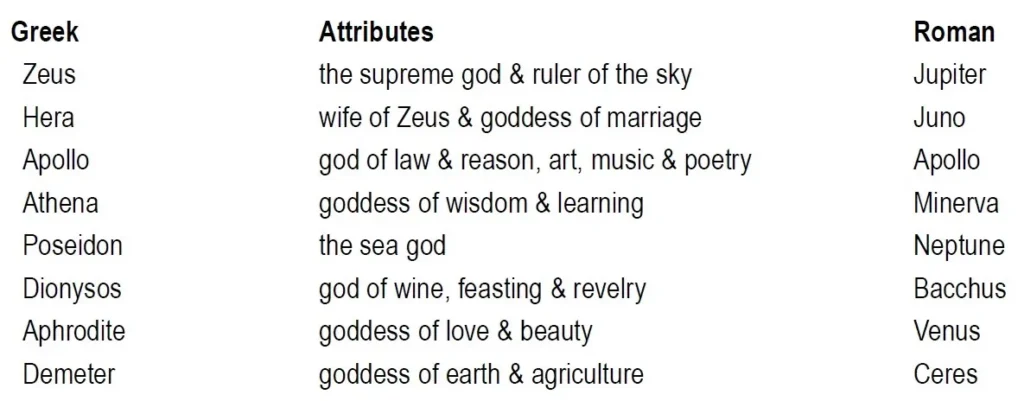
v) Historical and Social
- The Aegean culture between 1800-1600BC achieved a power co-equal with the civilization of Egypt and Mesopotamia.
- The Aegean culture embraced the civilizations of Crete.
- Cretans are also known as Minoans after the legendary king Minos of Knossos. They are equally known as Mycenaean, after one of the great centers, Mycenae.
- The Mycenaean culture was also referred to as Hellenic (classical Greece) and the root of Greek culture lies in Mycenaean culture (1600-110BC).
- The Aegean civilization centered on Crete was initiated by a movement of people from Asia Minor.
- They mingled with the ancient Mediterranean inhabitants; the civilization grew and expanded, developing a commercial empire protected by naval power.
- The Cretan superior trading civilization affected the inhabitants of what is now Greece exporting not only commerce but also cultural influences.
- At the end of the Bronze Age, wars between kingdoms destroyed most Mycenaean centres of power e.g. the Trojan War of 1200BC.
- The geography of Greece did not promote unity because of its rugged mountains, valleys and a jagged coastline.
- Ancient Greece was a disunited land of scattered city-states; thus, Greece entered into a period of relative impoverishment, depopulation and cultural isolation known as the Dark Age.
- Greek history could be divided into several periods;
The Orientalizing Periods (Dark Age) 1100-650BC
- There was increased wealth in Greece in the 7th century BC which was promoted by overseas trade and by colonizing activity in Italy and Sicily that had opened new markets and resources.
- Greece did not send out colonists and nor engaged in vigorous trade, and it declined as a cultural and artistic centre.
- City-states such as Corinth, Sparta, the islands, the cities of eastern Greece and Crete came to the fore with their diverse artistic interests and means of expression.
- The city-states demonstrated their wealth and power particularly in temple buildings, which was to foster new architectural forms, manifested in the decoration of the temples and of the national sanctuaries.
- In early Greek arts, the main role of the architect was to design cult buildings (temples), until the Classical period.
- However, regular visit of the Greeks to Egypt from about 650BC exposed them to Egyptian monumental stone buildings which were the genesis of the ultimate development of monumental architecture and sculpture in Greece.
- Wooden pillars were replaced with stone ones and the translation of the carpentry and brick structural forms into stone equivalents.
- This provided an opportunity for the expression of proportion and pattern, which led to the invention or evolution of the stone “orders of architecture”.
- These orders or arrangements of specific types of columns supporting an upper section called an entablature, defined the pattern of the columnar facades and upper works that formed the basic decorative shell of the Greek temple building.
The Archaic Period (650-475BC)
- The contact with Near Eastern cultures from the Dark Age became particularly visible influences on the art and culture of Greece during this period.
- Eastern imports into Greece of imitations of objects or motifs and trade were plentiful which led to new prosperity for Greece.
- The new prosperity brought about an age of preoccupation with domestic troubles rather than an age of reaching out to other cultures.
- Powerful dictators supported by arms and by the allegiance of the merchant classes, took over from aristocracies that had governed many of the city-states.
- The city-states became more powerful and more competitive as each court of these dictators became significant cultural centres.
- Monumental building programs became part of this competition, as each community attempted to establish itself as culturally superior.
- Temple buildings became more ambitious being the demonstration of the rulers‟ wealth and power.
- Hence city-states competed to erect the most beautiful buildings at religious sanctuaries that were Pan-Hellenic i.e. sacred to all Greece.
The Classical Period (475-323BC)
- The Persian Wars between Persia and Greece around 480-479BC, ended in victory for Athens and the Greeks.
- Considered as the culmination of Greek arts and architecture, with its highest achievements being the Temple of Zeus at Olympia and the Parthenon in Athens.
- People form every city-state came to Olympia to dedicate offerings to the gods and to compete in the Olympic Games which began in 776BC.
- The 4th and 5thcentury despite the political and military excesses, witnessed the great flowering of Greek philosophers of thinking, represented by Plato and Aristotle, particularly Socrates who were not only concerned with the nature of knowledge and the human soul, but there was also prodigious study in physics, mathematics, astronomy and music.
- However, Greek city-states still engaged in constant warfare until 338BC, when Phillip II of Macedonia and his son Alexander defeated the Greeks, thus ending the era of powerful independent city-states.
- Between 334-323BC, Alexander the Great extended his father‟s empire into Asia Minor (Turkey), Syria, Egypt, Persia (Iraq), Afghanistan and as far as India.
The Hellenistic Period (323-30BC)
- After Alexander the Great conquered the Greek city-states, his armies extended Greek civilization far beyond the Greek mainland into the Middle East.
- The 4th century witnessed various attempts by city-states to dominate Greece.
- The confused situation was resolved into a federal system imposed by the supremacy of Macedonia.
- The unification of Greece was accomplished under Phillip (359-335BC), and firmly established under his son Alexander the Great (336-323BC).
The early death of Alexander at the age of 32 was followed by the division of the empire among his army generals. - The empire was divided into three monarchies: Antigonius in Greece, Seleucis in Asia Minor and Ptolemy in Egypt.
- These were called Hellenistic (Greek-like) kingdoms, because the ruling classes spoke Greek and the official culture was Greek.
- The city-states failed to maintain unity; there was mutual animosity and economic decline during the 3rd century.
- The disorder created afforded opportunity for intrusion by the centralized, expanding power of the Romans, bringing with them law, order and unified government, and adopting much of the Hellenistic world.
- In the 2nd century BC, Rome dominated politics and began to exert its influence.
- Greece became a Roman province in 146BC, and Rome defeated the other Hellenistic kingdoms of Asia Minor and Egypt in 30BC.
vi) Social condition
- Civilization spread mainly through “Bronze Age” in the island of “Crete”. Trade & commerce, science & astronomy greatly spread.
- The Greeks were democratic. The idea was based on individual freedom.
- Greeks did not believe in life after death, hence there was little concern for tombs.
- Greeks national games and festivals encouraged literature, music and drama. Hence, Greeks constructed stadiums, palaestra (wrestling school), theatres, hippo drome( for horse and chariot race), basilica (assembly hall) and agora (open air market).
3) Architectural Typology
- Greek architecture consists of essentially building types that were enriched and refined over time, but rarely abandoned or replaced.
- It began with simple houses of the Dark Age and culminated in the monumental temples of the Classical Period and the elaborately planned cities and sanctuaries of the Hellenistic Period.
- Thus, the raw materials available and the technologies developed to utilize them largely determined the nature of their architecture.
i) Principal Building Materials
- Wood – used for supports and roof beams.
- Unbaked bricks – for walls, especially of private houses.
- Limestone and marble – for columns, walls and upper portions of temples and other public buildings.
- Terracotta (baked clay) – for roof tiles and architectural ornaments.
- Metals (especially bronze) – for some decorative details.
ii) Religious Architecture
- Open-air altars – served as the focus of prayer and sacrifices.
- Temples – housed the statue of a god or goddess to whom the sanctuary was dedicated.
- Treasury – a small-temple like building, in which offerings to gods and goddesses are made by city- states and citizens at sanctuaries such as Olympics and Delphi.
iii) Funerary Architecture
- Circular earthen mounds covering built tombs.
- Rectangular earthen mounds with masonry façades.
- Mausoleums (large independent tombs) or large stately tomb.
iv) Public Buildings
- Council House – venue where a governing council meet. The law court.
- The fountain house – a building where women filled their vases with water from a community fountain.
- Stoa – a roofed colonnade or porticoes open and having column on one side, and often with rooms set along the rear wall.
- Agora – an open assembly area or marketplace. It is the principal public gathering place of the city in which all other structures are lined.
v) Private Houses
They took many forms. They are:
- Early dwellings had just one room in the shape of a rectangle, oval or a rectangle with a curved back wall (an apse).
- The multiple rooms’ houses had airy and pleasant interiors, as they were generally organized around a small courtyard.
- The houses were never impressive from outside because their walls were of flimsy mudbrick or small stones.
vi) Entertainment and Recreation Buildings
- Open-air theatre
- Roofed concert hall.
- Gymnasium – an open field surrounded by rows of columns, where youths met for exercise and intellectual discussions.
- Stadium/Wrestling ground.
- Public Baths.
4) Architectural Orders
An order is a logical or methodical arrangement of components parts such that proper functioning, appearance or harmony is achieved.
Introduction

- They are pillars used in architecture to support the superstructure of a building, and occasionally as a free standing monument.
- They take different shapes, which may be circular or polygonal in cross-section, and are at least four (4) times taller than they are wide.
- The first columns constructed took shape from nature in the form of tree trunks or bundled reeds.
- This influence can be seen in the style of the stone columns used by the ancient Egyptian and in ancient Mediterranean city of Mycenae.
Architectural Orders and Major features of a Greek Temple
- By the end of the 7th century BC, the ancient Greeks developed three (3) major architectural orders i.e., Doric, Ionic and Corinthian order.
- The Doric is the oldest and simplest.
- The Ionic and Corinthian orders were more developed with elaborate schemes for the column’s capital and the entablature also differs in each case.
- The architectural orders determined the major features of an ancient Greek temple façade.
Classical Columns

- A column in classical architecture consists of a shaft, base and a capital.
- The capital serves as a visual and structural transition between the vertical shaft and the horizontal wall of masonry for the entablature under the roof.
- Several columns are placed in line in most cases so as to form a colonnade.
- The ancient Greece developed three (3) distinctive, carefully proportioned styles of columns – the Doric, Ionic and Corinthian orders.
Doric Order
- The Doric style is rather sturdy and its top (the capital), is plain. This style was used in mainland Greece and the colonies in southern Italy and Sicily.
- Used for the first time in the 7th century BC.
- It has no base, and the heavy shaft is tapered upward to the capital.
- The surface of the shaft has a slight convex curve, and is indented with shallow, vertical channelling or flutings.
- These features are also found in the ionic and Corinthian orders.
- The Doric capital consists of an undecorated, square slab resting on a rounded disc of stone that tapers down to the top of the shaft.
- Examples of Doric temples are: Temple of hera, Paestum; Temple of Poseidon, Paestum; Temple of Athena Parthenos, Athens; the Parthenon, Athens; the Hephaisteion, Athens.
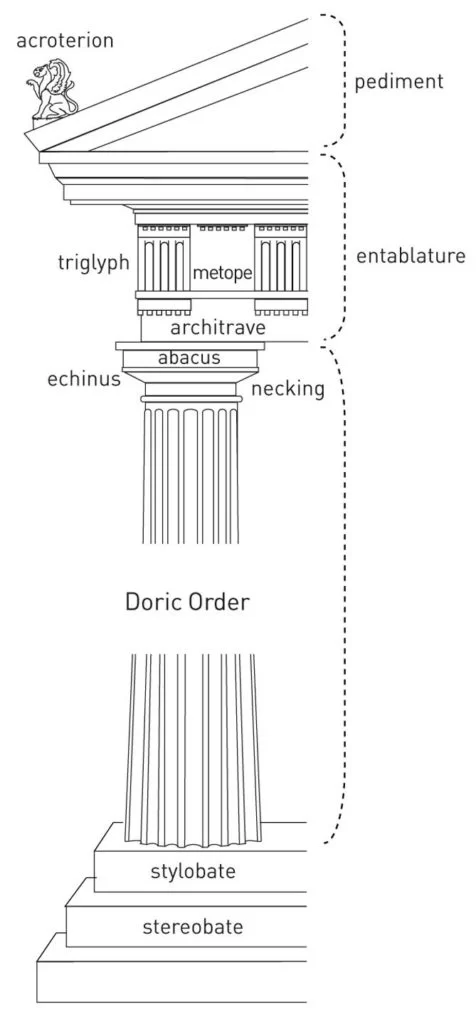
- Without base, directly on crepidoma.
- Height (including capital) of 4 to 6 times the diameter at the base.
- Shaft diminishes at top from 3/4 to 2/3 of base diameter. Divided into 20 shallow flutes separated by arrises.
- Doric capitals had two parts – the square abacus above and circular bulbous echinus below
- Doric entablature: Height is 1 and 3/4 times the lower diameter in height
- Three main divisions:
- Architrave, principal beam of 2 or 3 slabs in depth
- Frieze
- Cornice, mouldings
Ionic Order
- The Ionic style is thinner and more elegant. Its capital is decorated with a scroll-like design (a volute). This style was found in eastern Greece and the islands.
- Ionic order was introduced into Greece from Asia in the 6th century BC.
- The ionic column is more tapered than the Doric column and it rises from a richly moulded circular base.
- Projecting stone spirals known as volutes distinguishes its capital from the rest.
- Examples of Ionic temples are: the Erechteion, Athens; archaic Temple of Artemis, Ephesus; Temple of Athena Nike, Athens; Temple of Ilissus, Athens.
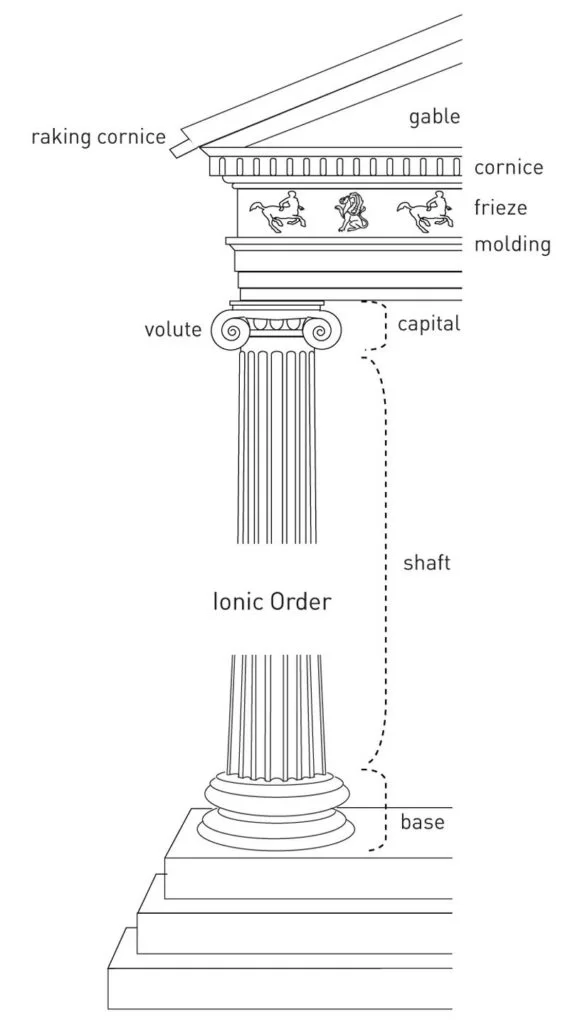
- More slender than Doric
- Needed a base to spread load
- Height was 9 times the base diameter
- Has 24 flutes separated by fillets
- Upper and lower torus
- Ionic entablature: Height was 2 and 1/4 times the diameter of column
- Two parts:
- Architrave, with fasciae
- Cornice
- No frieze
Corinthian Order
- The Corinthian style is seldom used in the Greek world, but often seen on Roman temples. Its capital is very elaborate and decorated with acanthus leaves
- Introduced in the 4th century BC as a variant of the Ionic column.
- It is characterized by a slender shaft.
- The capital is in the shape of an inverted bell, which is ornately decorated with volutes and acanthus leaves.
- Examples of Corinthian temples are: Temple of Zeus, Athens.
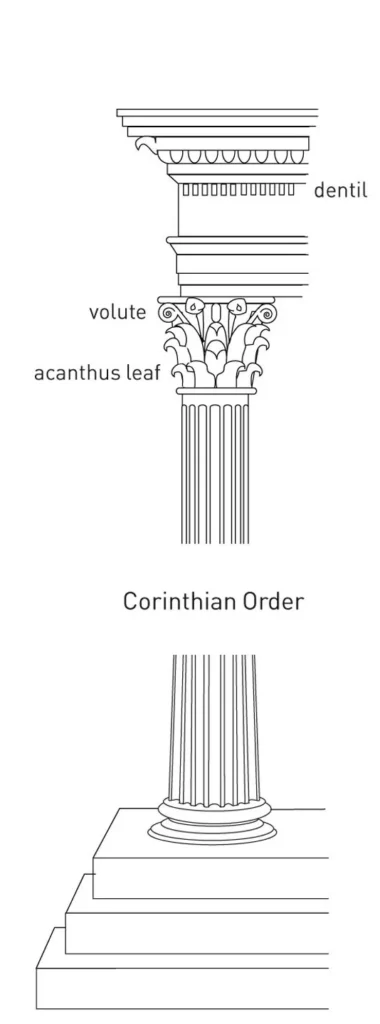
- Base and shaft resembled Ionic
- More slender
- Height of 10 diameters
- Capital: much deeper than Ionic, 1 and 1/6 diameters high
- Capital invented by Callimachus, inspired by basket over root of acanthus plant
- 3 parts:
- Architrave,
- Frieze,
- Cornice, developed type with dentils
5) Greek Temples
- The most characteristic Greek building is the colonnaded stone temple built to house a cult statue of a god or goddess; a statue to whom people prayed and dedicated gifts.
- The temple was developed in the archaic and classical periods.
- Typical temple had a rectangular inner structure known as a cella, which was normally divided by two interior rows of columns.
- The cult statue of the god or goddess usually stayed at the rear of this room.
- Most temples were orientated towards the east, and visitors entered on that side through a colonnaded front porch.
- Completely surrounding the inner core of the temple was a continuous line of columns called a peristyle.
- Peripteral temples are temples surrounded by columns on all sides thou there origin were debatable.
- The exterior colonnade became the principal distinguishing feature of most Greek temples.
- In the Dark Age, there was no obvious distinction between a temple and a house.
- The first monumental temples of stone were built in the 7th century BC in emulation of the massive buildings in Egypt that the Greeks would have seen or heard about.
- Egyptian influence also led the Greeks to begin to carve monumental stone statues at this time.
- Another factor which led to the great use of stone was the invention of heavy terracotta roof tiles, which needed more support than wood and mud brick could offer.
- Classical examples of Greek temples are: Temple of Zeus at Olympia, Erechtheion, Partehnon and Temple of Athena Nike at Athens.
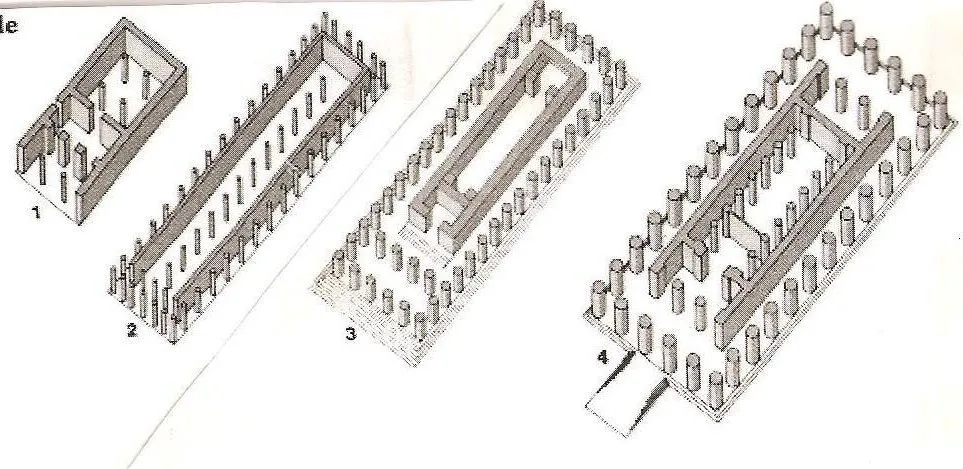
- THE DEVELOPMENT OF THE TEMPLE
- 1 – Mycenaean megaron at Tiryns, c. 1300 BC.
- 2 – The earliest temple ( probably Ionic ) at Samos, 9th century BC; a timber colonnade surrounded an unusually long chamber; inside, the roof was supported by a single row of columns.
- 3 – Temple C at Selinus, Sicily, mid 6th century BC; a chamber placed asymmetrically on a platform allowed a more imposing facade.
- 4 – Temple of Zeus at Olympia, c. 470 BC; its mature plan of 6 x 13 columns was popular in the early 5th century BC.
- A temple façade was made up of three (3) main parts;
- The steps
- Columns
- Entablature (the horizontal part that rested on the columns)
- Each of these three main parts also had three (3) distinguishing parts;
- The steps – it has three major steps leading into the temple, the topmost is called the stylobate.
- The columns – each column consisted of: Base, Shaft and Capital.
- The entablature – it consisted of: Architrave – plain horizontal beam resting on the column, Frieze – it corresponds to the beams supporting the ceilings and, Cornice – a set of decorative mouldings that overhung the parts below.
6) The Acropolis

- Acropolis is derived from two Greek words; akros – highest and polis – city.
- It is a fortified natural stronghold or the “Sacred Rock” of Athens, in ancient Greece, and it is the most important site of the town.
- It provided a place of refuge for the populace during times of war and also sanctuary for the ruler of the town.
- It served as the town’s religious centre and the focal point of its public life.
- The best-known acropolis of the ancient Greece is the Acropolis of Athens.
- It was built on a limestone hill that rises about 150 meters above sea level.
- In 480 BC the Persians destroyed the Archaic temples and monuments on the Acropolis, and for decades there was no major construction there.
- After the Persian Wars ended in 479 BC, Athenian democracy blossomed, its power expanded abroad, and Athens entered a period of great prosperity under the leadership of Pericles.
- Determined to make Athens the cultural leader of Greece, Pericles undertook one of the more remarkable building campaigns in history.
- The campaign centered on the Acropolis and began with the Parthenon (447-432 BC).
- It houses the remains of the Parthenon; a magnificent temple dedicated to the goddess Athena (Greek goddess of Wisdom), the Erechtheion, the temple of Athena Nike and the Propylaea (the monumental gateway of the Acropolis).

The Parthenon (447-432 BC)
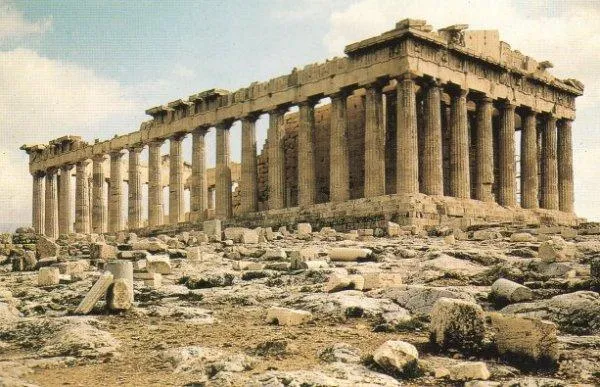
- It is the most important and characteristic monument of the ancient Greek and still remains its international symbol.
- Dedicated to Athena Parthenos, the patron goddess of Athens.
- Built about 447-432BC under the leadership of Pericles, by the architects Ictinus and Callicrates.
- Pheidias, a Greek sculptor in conjunction with other sculptors supervised the design of its sculptures.
- The temple is built in the Doric order and almost exclusively of marble.
- It is a rectangular (31x70m) peripteral-octastyle temple with eight columns on each of the narrow sides and seventeen columns on the long sides.
- The central part of the temple called the cella, housed the famous cult statue if Athena.
- It stands on a crepidoma of three steps; each of the steps is 508mm high and 711mm wide and as these were too steep to ascend with comfort, intermediate steps were provided at the center of the east
The Erechtheion (421-405 BC)
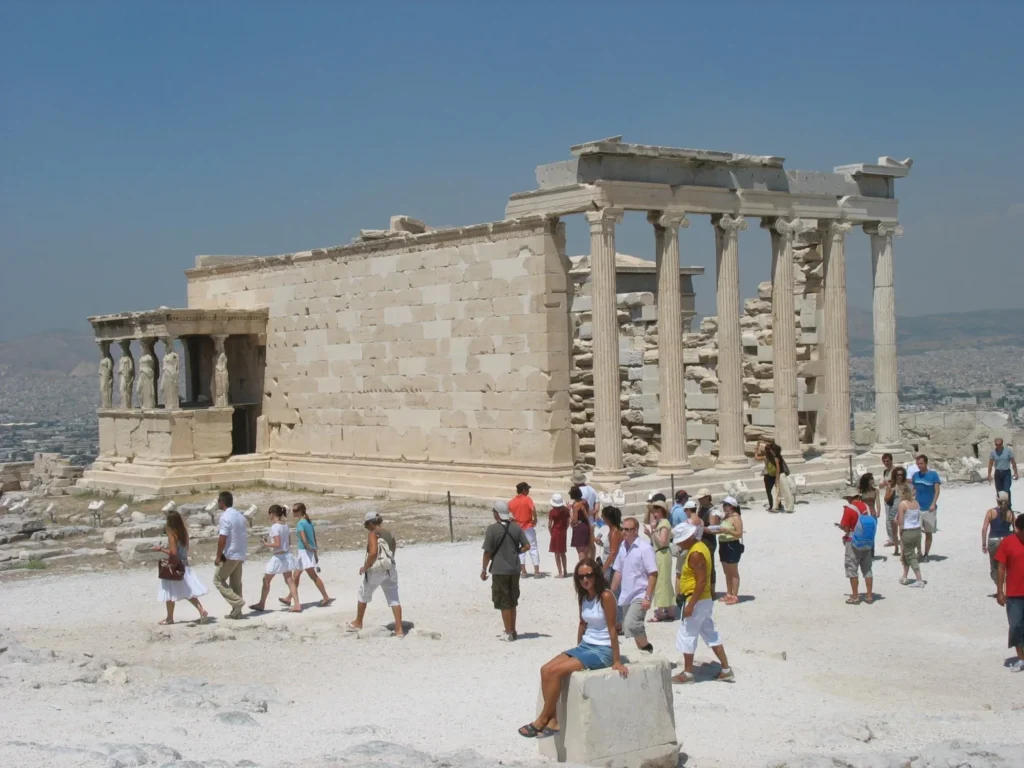
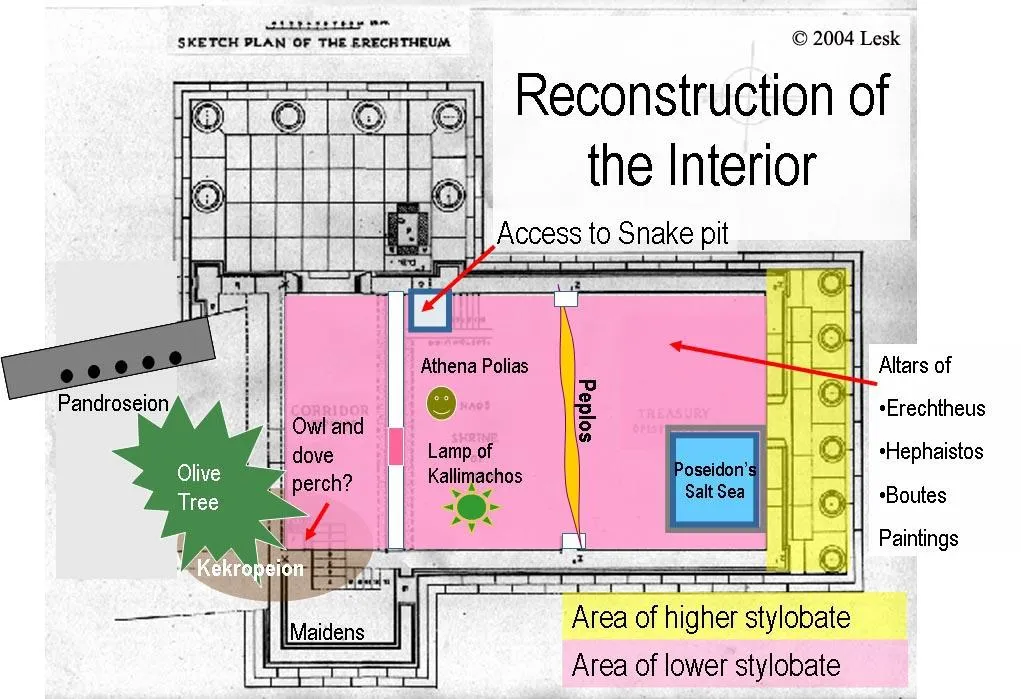
- It was built around 420 BC in the Ionic order with the famous entrance porch on the south.
- It was designed by Mnesikles with an unusual and irregular plan.
- The main temple was divided into two sections dedicated to the worship of the two principal gods of Athens – Athena and Poseidon.
- It is laid out in an unusual asymmetrical plan.
- A six-columned porch on the eastern facade is mirrored by six engaged Ionic columns on the western facade, which has no porch.
- Columned porches on the north and south sides are not centered, but are placed toward the western end of the building. The northern porch is larger than that on the south, and awkwardly extends beyond the west side of the building.
- The southern porch, sometimes called the Porch of the Maidens, has six marble maidens called caryatids that support the entablature in place of columns.
- The irregular plan of the Erechtheum can probably be explained by a need for it to incorporate several sacred places of worship already on the site.
- It was characterized by three porches and was constructed at two different levels (one side being 3.2meters below the rest).
- A flight of steps joined the two split levels.
The Temple of Athena Nike

- It was constructed around 420BC by the architect Callicrates.
- It was built in the Ionic order, and it is amphiprostyle (building with columns at each ends) with a row of columns in front of each of its narrow sides.
The Propylaea (437-432BC)
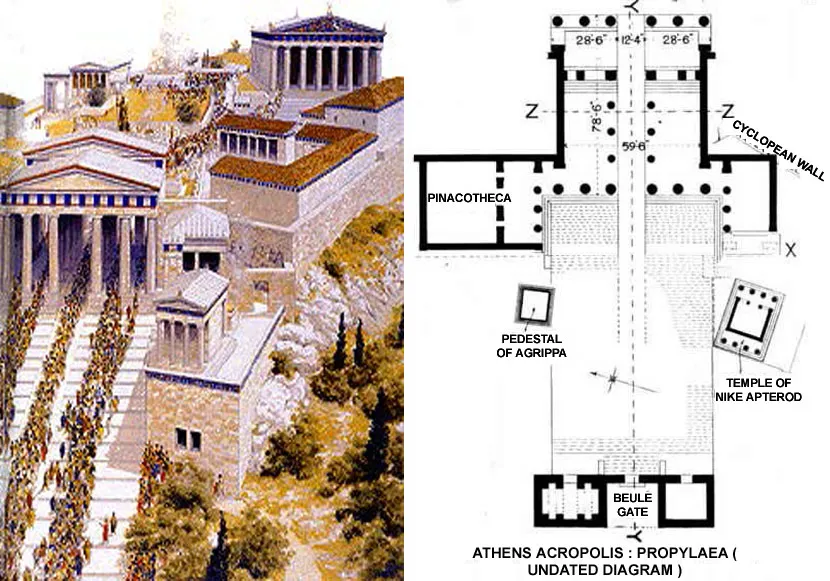
- It is the monumental gateway of the Acropolis on its steep western approach.
- It was designed by the architect Mnesikles and constructed in 437-432BC.
- It comprises of a central building and two lateral wings.
- The colonnades along the west and east sides had a row of Doric columns while two rows of Ionic columns divided the central corridor into three parts.
City planning
- In the early 5th century BC, cities were laid out in a grid-like plan with streets intersecting at right angles.
- In the 4th century BC, carefully planned cities and civic spaces became the rule in ancient Greece.
- Symmetry and geometric design played an important role in city planning.
- City planners designed distinct residential, marketing, recreation and religious areas and interspersed them evenly throughout the city.
Houses

- They varied according to the size of the land, the size of the owner’s family, his taste and wealth.
- Two standard plans emerged in the 5th and 4th centuries BC.
- The first had small rooms arranged in a rectangular plan around a colonnaded interior courtyard.
- The second types are larger houses which also focussed on interior courtyards.
- They are with two courts, one behind the other and each with its own dependent chambers (rooms).
- The entrance court is the Court of the Men (Andronitis).
- Women of the house retire promptly on the appearance of a male stranger.
- There is a small stone altar at the center of the colonnaded court with a statue of Zeus the Protector, where the master of the house offers sacrifice.
- Andronitis is the true living room of the house where the master receives visitors.
- The chambers in the andronitis (12 in all) open to the colonnaded courtyard on all four sides.
- The chambers are small and usually lighted only by their doors; used for storerooms and for sleeping for male slaves and for the grown-up boys of the house.
- Because the room are poorly lit and ill ventilated, the average Athenian loves the agora better than his chamber.
- Directly behind the andronitis is the dining hall of the house (Andron).
- At one corner of the andron is a little round altar sacred to Hestia, the hearth goddess.
- The andron also contains the great bedroom of the master and mistress (the thalmos), and another of such bedroom for the grown-up girls of the hoiuse (anti-thalmos).
- Behind the andron is the Court of the Women (Gynaeconitis) – the holy of the holies.
- Greek women are forbidden to participate in so much of public life; to enter into the gynaeconitis of even an intimate friend is an insult at Athens and may lead to a ruinous legal prosecution or bodily chastisement.
- The gynaeconitis consists of the kitchen, rooms for slave women, and in a home of a well-to-do family, a garden.
Greek architecture has continued to influence architects and designers throughout the centuries and is still regarded as a model of classical beauty and proportion. Its legacy can be seen in buildings all over the world, from public buildings and monuments to private homes and gardens.